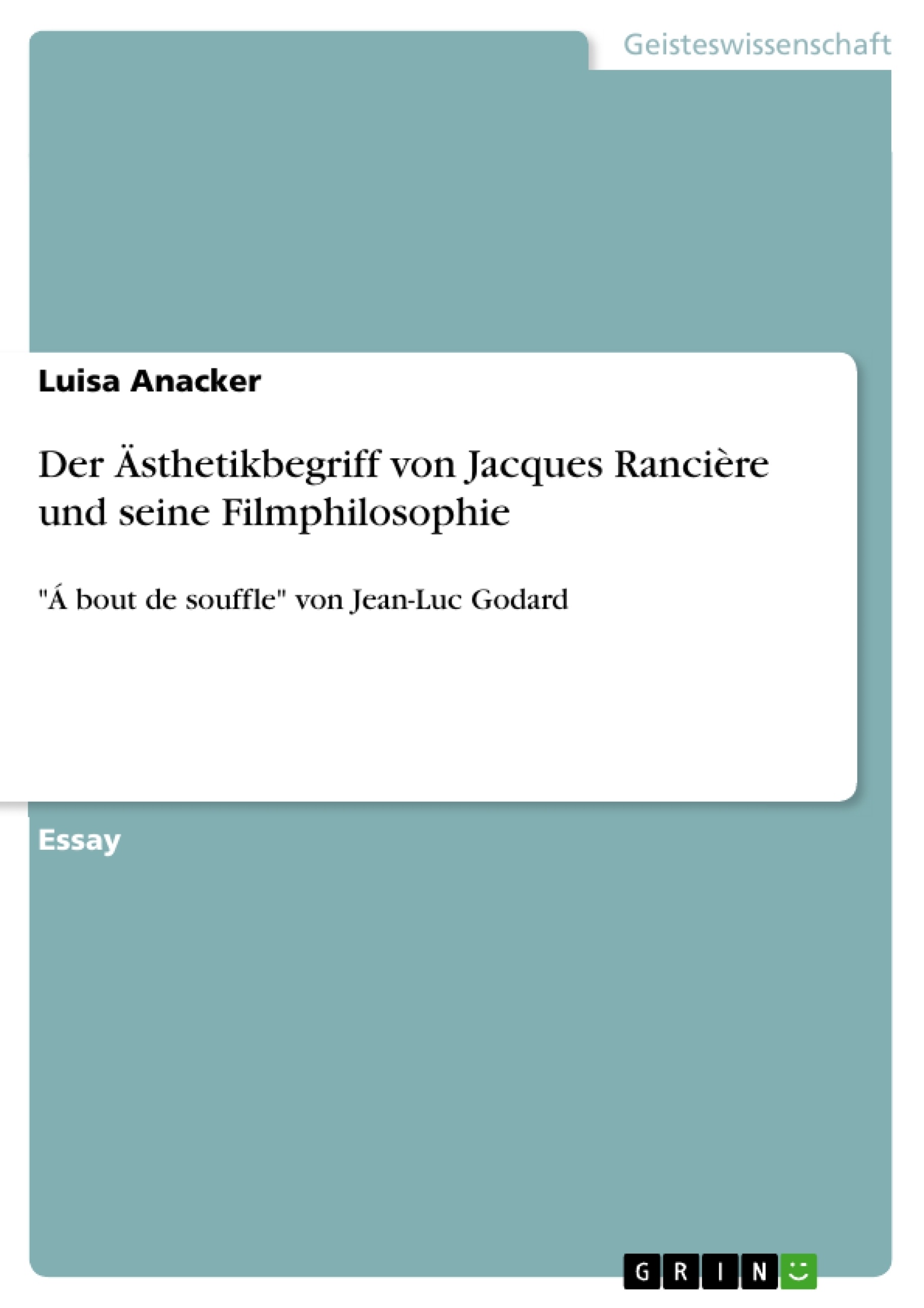Die nachfolgende Arbeit befasst sich mit Jacques Rancières Ästhetikbegriff und deren Bezug zum Film. Jacques Rancière hat zahlreiche Texte über das Kino verfasst und sich als einflussreicher Theoretiker zu Fragen der Ästhetik einen Namen gemacht, vor allem in Bezug auf den Film und die Medienkunst. Die Arbeit untersucht, ob die Betrachtung des Ästhetikbegriffs bei Rancière hilft, seine Filmphilosophie zu verstehen. Im Ausgangspunkt steht die Betrachtung des französischen Films „Á bout de souffle“ von Jean-Luc Godard. Als Filmautor spielt Godard besonders im Zuge der Nouvelle Vague Filme in den 60er Jahren eine besondere Rolle.
Genauso wie Rancière eine eigene Art hat, das Kino zu untersuchen, ist auch seine Auffassung des Ästhetikbegriffs sehr eigen. Kunst ist für Rancière nicht definierbar und ist nur in einem subjektiven Prozess heraus ermittelbar. Er schließt damit an Traditionen großer Philosophen an, die für die stetige Widerständigkeit der Kunst plädierten.
Die Arbeit spiegelt notwendigerweise den Konflikt den die Ästhetik seit über zweihundert Jahren auszutragen hat wieder. Im Mittelpunkt dieses Konflikts steht die ästhetische Konfusion, welche einen Bruch der Repräsentationsweisen in der Kunst darstellt. Hier genau schließt Rancières Denken an, weil er im Gegenstand dieses unstimmigen Verhältnisses, das mit dem Bruch der Re-präsentationsweisen in der Kunst zu beschreiben ist, das meint, was er das ästhetische Regime der Kunst nennt und für ihn die neue Bezeichnung der Ästhetik ist.
Die Arbeit bezieht sich auf das neuste Werk von Jacques Rancière, das er zum Thema Film veröffentlicht hat. In Die Spielräume des Kinos von 2012 führt er zwei wesentliche Punkte auf. Zum einen setzt er sich mit der Cinephilie auseinander, die Rancière als Passion des Kinos bezeichnet, und einen Wandel in der Art und Weise wie Kino darstellt erzeugt hat und zum anderen zeigt Rancière die Grenzen der Darstellbarkeit des Kinos auf und betrachtet sie anhand der Werke von berühmten Regisseuren, wie Hitchcock, Bresson, Rosselini und Straub.
Häufig gestellte Fragen
What is the main topic of the "Inhaltsverzeichnis" language preview?
The main topic is Jacques Rancière's concept of aesthetics and its relation to film, particularly focusing on the cinematic work of Jean-Luc Godard and the influence of Cinephilie.
What are the key themes explored in the language preview?
Key themes include the definition of aesthetics, the aesthetic regime of art, the relationship between aesthetics and politics, Cinephilie and its impact on cinema, and the boundaries of representation in film.
What is the "ästhetische Konfusion" mentioned in the language preview?
The "ästhetische Konfusion" refers to a break in the modes of representation in art, creating an unstable relationship between various artistic elements and everyday experiences. It is a central concept discussed in relation to Rancière's theories.
What is meant by the "ästhetische Regime der Kunst" according to Jacques Rancière?
The "ästhetische Regime der Kunst" is Rancière's term for the new designation of aesthetics, representing a specific historical regime of thinking about art, where objects of art are considered objects of thought.
What is the role of Cinephilie in relation to the "Inhaltsverzeichnis" preview?
Cinephilie, which is described as the passion for cinema, is explored in the "Inhaltsverzeichnis" as a transformative force in how cinema is presented and perceived. It blurs the boundaries between art and entertainment, creating a new understanding of cinema's significance.
What is the significance of Jean-Luc Godard's film 'A bout de souffle' (Breathless) in this context?
Godard's 'A bout de souffle' serves as an example of the Nouvelle Vague movement and its innovative filmmaking techniques, and its a significant piece of work in understanding Rancière's perspective on aesthetics and film, exemplifying new ways of cinematic representation.
How does Rancière define the relationship between aesthetics and politics?
Rancière believes that aesthetics has its own politics. He considers that politics relates to what can be seen and said, while aesthetics has political effects through distancing and creating new modes of community.
What does Rancière mean by the "Politik des Laien" in cinema?
The "Politik des Laien" is a method of analyzing film free from the authority of scholarship, which analyzes cinema freely, and states the boundaries of their territories are at the intersection between experience and learning.
What is Rancière's viewpoint on the role of an artist?
Art is only to be understood from a subjective process. Thus, Rancière follows Kant, Schiller, and Adorno, in believing that art is un-definable.
- Arbeit zitieren
- Luisa Anacker (Autor:in), 2015, Der Ästhetikbegriff von Jacques Rancière und seine Filmphilosophie, München, GRIN Verlag, https://www.grin.com/document/339015



